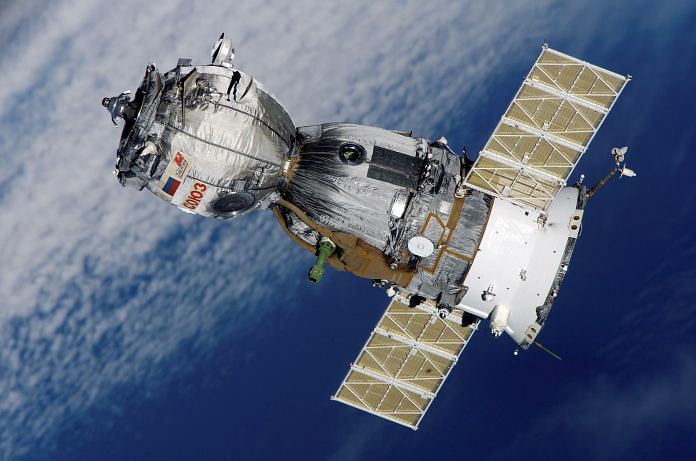We’ve launched 9,600 satellites since 1957. For the first few decades, no one thought about what would happen once they reached the end of their lives. By the time space agencies decided to do something, it had become a problem.
“A vast majority of objects in orbit are effectively stranded there,” says Stijn Lemmens, a space debris analyst at the European Space Agency. “And they have a lifetime of hundreds, thousands of years.”
Old satellites are dead weight, tumbling pieces of metal orbiting our planet, threatening to explode or crash against active equipment essential to communications, weather forecasting and navigation. Each collision breaks large objects into smaller pieces, leading to an exponential growth in debris.
There are about 34,000 fragments larger than 10 centimeters, and over 128 million objects even smaller than that floating around in space, according to ESA. That number will rise as we launch more rockets and satellites, and as debris-creating events become more common.
While our efforts to radically curb plastic waste on Earth have so far been unsuccessful, we’ve actually made some progress in space.
In the late 1990s and early 2000s the international community started to get serious about the problem. Guidelines were set encouraging operators to equip satellites with debris mitigation systems. While they’re not compulsory, ESA research shows between 60% and 90% of new satellites launched since 2000 into the so-called geostationary orbit are complying.
The success is partly because all satellites there share the same orbit, a stretch exactly 35,786 kilometers (22,236 miles) above the Equator, so physical space is limited. One collision can harm one’s own equipment, and force every satellite to dodge tumbling debris —forever. “There is a strong awareness and incentive among operators to behave responsibly there,” Lemmens says.
The solution is simple: a reserve of fuel allows satellites to just leave the geostationary orbit when they reach the end of their lives, joining orbits where no active satellites operate.
The lower orbits, between zero and 2,000 kilometers from the Equator, are proving more challenging. There, only between 5% and 10% of objects have successfully complied with debris mitigation measures. That’s a concern, because it’s where the growth is happening, Lemmens says.
Possibly the most ambitious low-orbit project is Elon Musk’s Starlink, which aims to launch a constellation of 40,000 satellites to beam broadband internet around the world. Almost 700 Starlink satellites have been launched since May last year, meaning Musk has single-handedly increased the number of active satellites by almost a third.
Guidelines establish these low-flying satellites should leave the region they operate in within 25 years, slowly orbiting back to Earth until they reach the atmosphere and self-destroy. ESA is now working on an index that it hopes will raise awareness among the hundreds of players, from governments to universities, launching satellites into lower orbits. The index will indicate a risk metric showing how vulnerable a satellite is to fragmentation and collision.
Of course, the old satellites and the millions of shards resulting from the collisions will still be there. But space agencies are developing new technologies to deal with them. The first step is approaching the satellite aided by computer vision technology. Next, agencies advise capturing the waste with harpoons, nets or robotic arms. The goal is to get it back to Earth in one piece, or to get them to approach our planet and self-destroy as they reach the atmosphere.
Lemmens says it’s applicable to tackling the ocean waste problem, too. “Think about active removal missions: the robotics, the guidance, navigation and control required,” Lemmens says. “You can imagine that the same type of algorithms can afterwards be used on Earth applications as well.”
The environment out there is harsher, sure, and some technology needed in space is rather specific. A satellite is not the same as a plastic bag. And yet, with so many common traits to both problems, it’s tempting to think that solutions that work for one could help us solve the other.
“Both on Earth and in orbit the point is always that once we have completed our main mission, we forget about the consequences on the long term,” Lemmens says. “It’s a human reflex not to think about these time scales, both on Earth an in orbit, but the solution might be of the same nature.” – Bloomberg
Also read: There are up to 14 million tonnes of microplastics on the seafloor — worse than we thought




I wish I could put this article in perspective. I’ve read several articles now about space debris in orbit and the dangers of it. I’m old I actually remember and old Lost in Space episode where it was an issue. but here’s my concern and question that I can’t seem to find a ready answer to. How much of the debris is natural debris IE meteor fragments and space dust xcetera. I mean the Earth passes through meteor showers all the time and I believe there’s probably billions of tons of space debris in orbit that was naturally occurring. can someone at least give me a percentage? Or is the amount of man-made debris actually quite marginal?
I wish I could put this article in perspective. I’ve read several articles now about space debris in orbit and the dangers of it. I’m old I actually remember and old Lost in Space episode where it was an issue. but here’s my concern and question that I can’t seem to find a ready answer to. How much of the debris is natural debris IE meteor fragments and space dust xcetera. I mean the Earth passes through meteor showers all the time and I believe there’s probably billions of tons of space debris in orbit that was naturally occurring. can someone at least give me a percentage? Or is the amount of man-made debris actually quite marginal?